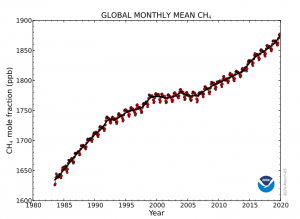 By Stefan Schwietzke and Steven Hamburg
By Stefan Schwietzke and Steven Hamburg
A decade of extensive scientific research has demonstrated that methane emissions from the oil and gas supply chain have been substantially underestimated and has placed pressure on governments and industry to act. Because of methane’s potency and the feasibility and cost efficiency for reducing emissions of it, methane presents among the most powerful opportunities we have to slow the rate of planetary warming in our lifetimes.
Still, methane research continues — the more precisely we can identify global emission sources and quantify their volume, the more precise and effective mitigation efforts will be. And as this challenge is examined by different teams with different methods, we sometime have to address discrepancies among the results. Such is the case with two new papers that examine the proportion of rising atmospheric levels of methane associated with shale gas production in the United States. We know oil and gas methane emissions are higher than previously thought — and the scientific debate surrounding these papers is about where the global increases in emissions are coming from.
Atmospheric methane levels vis-a-vis U.S. shale gas
The two new papers, one published in Scientific Reports and one undergoing peer-review in Biogeosciences, reevaluate the U.S. shale gas industry’s contribution to surging global atmospheric methane concentrations and provide additional data to address the thesis that the shale gas boom is a major contributor put forward in a 2019 paper published by Robert Howarth. (An EDF scientist is a co-author of the Scientific Reports paper.)
The U.S. shale gas boom has indeed impacted the global energy industry — it was responsible for about two-thirds of the increase in global gas production between 2008 and 2014. Howarth estimated that the U.S. shale boom contributed more than half of all of the increase in methane emissions from global fossil fuels (including oil and coal) and one-third of the total increase from all global emission sources (human caused and natural) during the same period.
Greatly expanded datasets used in the two new papers calculate increased emissions from expanded U.S. shale gas production of 6.8 million metric tons, only 72% of the emissions estimated in the Howarth paper.
What’s increasing global methane levels? New research examines role of U.S. shale gas. Share on XBetter datasets yield better insights
As a reference of the large magnitude, Howarth concluded that U.S. shale gas methane emissions increased by 9.4 million metric tons between 2008 and 2014. This is equivalent to about two-thirds of the total U.S. oil and gas methane emissions in 2015 as estimated in a comprehensive synthesis paper published in Science in 2018, an effort led by EDF scientists.
Total U.S. natural gas and oil production has increased by about 25% and 75%, respectively, over the same period. Howarth’s emissions estimate is thus not implausible; it’s not surprising for emissions to increase alongside production. Howarth, however, asserted that the evidence goes beyond this simple correlation, and this is where the new papers, based on exhaustive data, suggest different results.
To determine changes in methane emissions over time, Howarth relied on isotopic signatures — the difference in the average chemical structure of an atom inside of a methane molecule. Accurately determining average isotopic signatures requires large datasets. Higher uncertainty is associated with the Howarth conclusion because of the small number and limited geography of the data he relies on. The two new papers deploy datasets with about 100 times more data that is also more representative of the actual population being examined.
Additionally, the Biogeosciences paper estimates the emission trend from conventional oil and gas and coal at 6.9 million metric tons over the same period (18% less than Howarth). Importantly, both of the new papers also point out the limitations of using the isotope method per se for linking the shale gas boom with the observed global methane trend. Accounting for difficulties, including Howarth’s model’s parameterization and oversimplifications of the global methane sources and sinks, would lead to uncertainties that have not yet been quantified.
The scientific debate about how much of the rise in atmospheric methane concentrations is due to the oil and gas industry does not impact the robust conclusion that methane emissions from the oil and gas industry are currently high, much higher than previously thought. The Scientific Reports paper authors stress that “oil and gas industry expansion remains a significant factor in the complex patterns of global atmospheric methane emissions and concentrations, [and] fossil fuel methane sources may be mitigated with policy and best (or better) industrial practice that can effectively reduce emissions.”
No debate about the need to reduce methane
The more we know about methane emissions, the better. But it’s important that efforts to learn more about what is happening and why are not misinterpreted as a debate about the need to mitigate methane emissions. All three papers discussed point to emission levels that pose a significant threat to the climate.
Methane emissions from human activities are driving more than 25% of the warming we are witnessing now, and roughly 80% of the cost-effective reductions in methane emissions available today are to be found in the oil and gas supply chain. About that, there is no debate.









